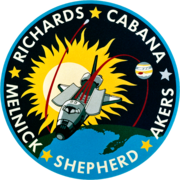
Back STS-41 Arabic STS-41 Bulgarian STS-41 Czech STS-41 Danish STS-41 German STS-41 Spanish استیاس-۴۱ Persian STS-41 French STS-41 Galician STS-41 HE
 Ulysses and its Inertial Upper Stage (IUS) in the payload bay of Discovery | |
| Names | Space Transportation System-41 |
|---|---|
| Mission type | Ulysses spacecraft deployment |
| Operator | NASA |
| COSPAR ID | 1990-090A |
| SATCAT no. | 20841 |
| Mission duration | 4 days, 2 hours, 10 minutes, 4 seconds |
| Distance travelled | 2,747,866 km (1,707,445 mi) |
| Orbits completed | 66 |
| Spacecraft properties | |
| Spacecraft | Space Shuttle Discovery |
| Launch mass | 117,749 kg (259,592 lb) |
| Landing mass | 89,298 kg (196,868 lb) |
| Payload mass | 15,362 kg (33,867 lb) |
| Crew | |
| Crew size | 5 |
| Members | |
| Start of mission | |
| Launch date | October 6, 1990, 11:47:15 UTC (7:47:15 am EDT) |
| Launch site | Kennedy, LC-39B |
| Contractor | Rockwell International |
| End of mission | |
| Landing date | October 10, 1990, 13:57:19 UTC (6:57:19 am PDT) |
| Landing site | Edwards, Runway 22 |
| Orbital parameters | |
| Reference system | Geocentric orbit |
| Regime | Low Earth orbit |
| Perigee altitude | 300 km (190 mi) |
| Apogee altitude | 307 km (191 mi) |
| Inclination | 28.45° |
| Period | 90.60 minutes |
| Instruments | |
| |
 STS-41 mission patch  From left: Melnick, Cabana, Akers, Richards and Shepherd are pictured in front of the T-38 jet trainer | |
STS-41 was the 36th Space Shuttle mission and the eleventh mission of the Space Shuttle Discovery. The four-day mission had a primary objective of launching the Ulysses probe as part of the "International Solar Polar Mission" (ISPM).
© MMXXIII Rich X Search. We shall prevail. All rights reserved. Rich X Search